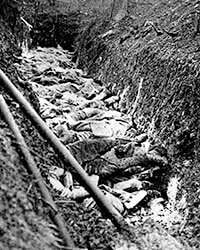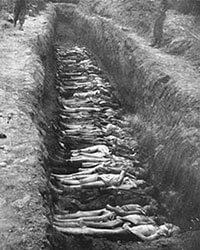 |
 |
| Mass-graves, World War I & the Holocaust |
What was the difference between the slaughter that occurred during the First World War and that which occurred during the Holocaust? Some might say the killing in the Holocaust was intentional, whereas the killing of the First World War was—what— unintentional? Asking men to get out of trenches and run into machine gun fire and artillery shells for four years—were their deaths an accident? |
|
|
In his presentation, Industrial Killing: World War I, the Holocaust, and Representation, Omer Bartov stated that the First World War introduced to the West a “new concept of war” that had far-reaching consequences. He called this “industrial killing,” the “mechanized, impersonal and sustained mass-destruction of human beings, organized by states.” This “mass slaughter in the trenches,” Bartov explained, has had a “direct and long-lasting effect on Europe,” and subsequently on the rest of the world.
In the book upon which his lecture was based, Murder in Our Midst: The Holocaust, Industrial Killing, and Representation (Oxford University Press, 1996), Bartov suggests that the “very concept of mass-killing of human beings by states”—the genocide of the Jews—was “lifted directly from the Great war”—from the realities of 1914-1918.
The death camps were architecturally and organizationally modeled on the experience of the Great War, “incorporating all the attributes of a military environment,” such as uniforms and barbed wire, watch towers and roll calls, hierarchy and order, drill and commands. The Holocaust was therefore a “militarized genocide.”
The Holocaust, Bartov says, was “almost the perfect reenactment of the Great War,” with the important correction that “all the perpetrators were on one side and all the victims on the other.” In other words, in the First World War everyone was a victim—or rather soldiers were simultaneously those who killed and those who were slaughtered. The war was a kind of “mutually assured destruction.”
Bartov observes that what was present during the First World War was also present at the death camps: the barbed wire, machine guns, charred bodies, the gas, the uniforms, and the military discipline. This reenactment, however, had the great advantage that it was “totally lethal for the inmates and totally safe for the guards.
The word “reenactment” is apt. Based on 19 years of research subsequent to this Conference, I have concluded that—in essence—this is what the Holocaust was: a reenactment of the First World War.
To understand this interpretation, one simply needs to recognize that Hitler was the prime mover. Yes, there were numerous functionaries who executed the plans (I’m familiar with the arguments), but Hitler was at the heart and soul of everything that occurred in Nazi Germany. The Holocaust represented the execution or enactment of Hitler’s desires and fantasies.
Hitler fought in the First World War for four years, 1914-1918, witnessing the slaughter of hundreds of comrades. He was in the trenches to receive artillery bombardments (almost was killed himself on several occasions). Crawling as a messenger, it’s a miracle he survived the machine gun bullets. At the end of the war, Hitler was the victim of a poison gas attack—nearly blind in a hospital when the war ended.
The key concept illuminating the Holocaust in its relationship to the First World War is “Do unto others as has been done unto you.” In creating the death camps, Hitler was recreating or reenacting his own traumatic experience of the First World War, as well as Germany’s trauma.
Two-million German soldiers died in the First World War, and millions more were injured. Hitler was well aware of the statistics. In the Holocaust, there would be no German victims—only Jews.
Bartov concludes by observing that there is much reluctance to “associate the imagery of the Great War with the Holocaust.” This has to do both with the discomfort of “perceiving national wars as instances of industrial killing,” and with the general tendency to insist on the “difference between genocide and war.”
What was the difference between the slaughter that occurred during the First World War and the slaughter that occurred during the Holocaust? Some might say that the killing that occurred in the Holocaust was intentional, whereas the killing that occurred in the First World War was—what—unintentional? Asking men to get out of trenches and to run into machine gun fire and artillery shells for four years—were their deaths an accident? |